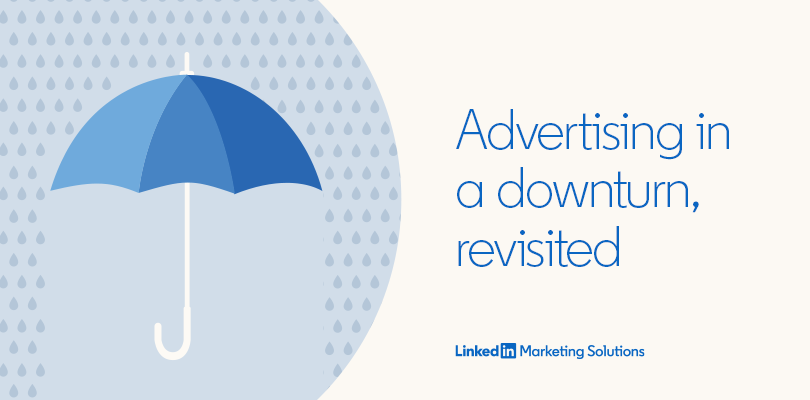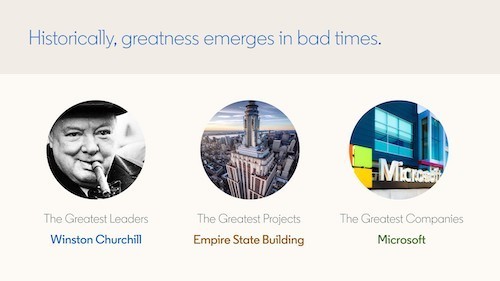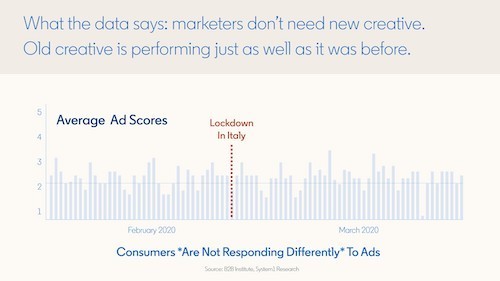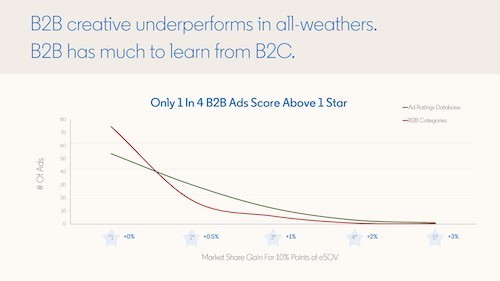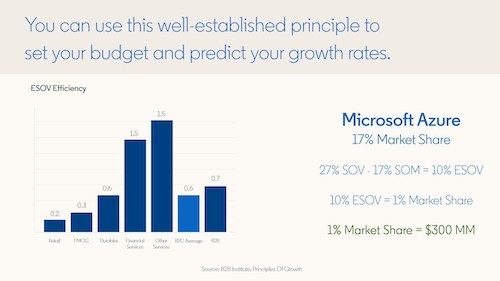All-Weather Marketing
Editor's Note: This post was co-written by Jon Lombardo, Global Lead, The B2B Institute. Join Jon, Peter, and Ty Heath for the webinar, "All Weather Marketing: Weather the Storm and Win Market Share" on May 28.
There are good times and there are bad times.
Unfortunately, we are now living through bad times, with the COVID-19 pandemic plunging the world into crisis. And although we all prefer good times to bad times, history teaches us that what we do in bad times often matters more than what we do in good times.
Why?
Because greatness is born in bad times.
Our most remarkable achievements often occur in our darkest hours. We are at our best when things are at their worst. Our greatest leaders, like Abraham Lincoln, overcame our greatest challenges, like The Civil War. Our greatest projects, like the Empire State Building, were constructed during our most difficult periods, like The Great Depression. Many of our greatest businesses, like Microsoft, were founded during severe economic downturns.
The truth is that you can’t be great without a great challenge. Eleanor Roosevelt said it best: “A woman is like a tea bag — you can’t tell how strong she is until you put her in hot water.” It’s easy to succeed in good times, when civilization progresses safely and steadily, sentiment flies high, and the stock market booms. But succeeding in bad times requires extraordinary skills.
To succeed in bad times, you need to keep your calm, when everyone else panics. You need to think rationally, when others can’t. You need to trust reliable data over unreliable opinions. That holds true in politics, in culture, and in business. But let’s focus on business for now.
Ray Dalio is one of the most successful businessmen in history, and he owes his success to an important insight: success is determined by how you perform in bad times, not good times. In pursuit of this insight, Dalio invented “The All-Weather Fund,” a portfolio designed to perform well during both booms and busts. He constructed this fund by examining historical financial data to find the assets that perform well during both booms and busts, or “good weather” and “bad weather.” So when the 2008 crisis hit, Ray Dalio’s “All-Weather Fund” was up 9%. Meanwhile. the broader S&P 500 was down 37%. In part based on this astonishing success, his firm, Bridgewater Associates, went on to become the world’s biggest hedge fund.
Dalio kept calm, when others panicked. He used good data to make good decisions.
To succeed in bad times, marketers need to follow a similar formula.
There are many opinions swirling around on how best to market during this downturn. But what does the data say? Well, we’ve partnered with two of the most rigorous thinkers in the industry, Peter Field and Orlando Wood, to develop “All-Weather Marketing,” a data-driven strategy designed to perform well in both good times and bad times. Our primary focus will be on advertising, which is (at least in theory) just one of many tools available to marketers.
All Weather Marketing: The Right Strategy
First, let us start with a caveat. The highest priority for any business is survival. This crisis is an existential threat for many businesses, and in those dire circumstances, marketing may not be a viable solution to the problem. If you don’t have enough cash to pay your people, to cover your rent, or to keep the assembly lines rolling, then you should probably ignore the advice we are about to offer you. You can’t market if you don’t stay in business.
But some businesses are not fighting to survive. Some business are investing to thrive. And for those business, we’d like to direct your attention to one of our favorite Case Studies in All-Weather Marketing: the story of Kellogg’s rise to market dominance.
In the 1920s, Kellogg’s was a market laggard, and Post was the market leader. But then came the bad times — the Great Depression. Post reacted like every other brand and slashed its marketing budgets. Kellogg, on the other hand, doubled its ad budget, invested in radio (the “digital” of that era), and launched a new product called Rice Krispies. As documented in The New Yorker, by 1933, “even as the economy cratered, Kellogg’s profits had risen thirty per cent and it had become what it remains today: the industry’s dominant player.” And those of you who are watching CNN 18 hours a day, like us, have probably noticed that Kellogg’s is advertising right now, promoting Rice Krispies as a normal breakfast in abnormal times.
So, what can we learn from Kellogg’s about marketing in bad weather?
Well, let’s start with the most important lesson: do not cut your advertising budget. Remember that advertising is “game theoretical” — you need to reach more customers than your competitors in order to grow. If your competitors pull back, and you push forward, you will reach most of the market, and increase your market share. In fact, it may sound counter-intuitive, but the best time to advertise is when no one else is advertising.
Our research with Peter Field backs this view with data. Peter Field examined the case studies in the IPA databank, and looked at the business impacts of different marketing strategies during the 2008 recession. What he found is that marketers who increased advertising investment got 4.5 times as much market share growth as brands that did not.
We have confidence in this finding because it replicates the findings of many other researchers. First, we know from academic research that share of voice (SoV) matters in good times, so we’d expect SOV to matter in bad periods — maybe doubly so — when competitors cut advertising. Second, a 2003 MSI study from Frankenburger and Graham concluded that “advertising creates a firm asset by contributing to financial performance for up to three years in the future…[and] increasing spending on advertising during a recession leads to benefits that exceed the benefits of increasing advertising during non-recessionary times.” And there are a series of other studies from PIMS in the 1980s to Roland Vaile in the 1920s, that, while imperfect, suggest brave brands that keep advertising in downturns see growth in market share and sales volume.
A century’s worth of research suggests that advertising reduces your downside during bad times and increases your upside during good times. Remember that most of the effects of advertising are long-term, and in the long-term, our economies will recover, so it makes sense to prepare for better weather. Peter Field said it best in our report, “Brand advertising is not about profiting in a recession, it is about capitalizing on the recovery.”
Smart investors know not to panic-sell stocks during a downturn. In fact, many investors consider downturns to be a “buying opportunity.” To quote our close personal friend, Warren Buffett: “Whether we’re talking about socks or stocks, I like buying quality merchandise when it is marked down.”
Marketers should not panic-cut advertising. Media prices are falling as advertisers pull back, despite a rise in usage. If you can afford to advertise, this is a Buffett-worthy buying opportunity. Cutting your spend may free up short-term cash flows, but it will also slow your future cash flows. And as any good CFO can tell you, businesses are valued based on future cash flows.
All Weather Marketing: The Right Creative
Ok, perhaps we’ve convinced you to invest in advertising in bad times. But what changes should marketers make to their creative? The world has changed, shouldn’t your ads change too?
Short answer: probably not.
Most marketers believe their creative needs to change. According to the IAB, 83% of marketers plan to adjust their creative messaging as a result of the pandemic. Many marketers believe that old creative will be seen as “opportunistic” and offensive to consumers, who are afraid for their safety and worried about their financial security. It’s a reasonable concern.
In fact, our research with Orlando Wood reveals the opposite: customers are reacting no differently to ads, and some ads are performing even better than before. In the data below, you can see that ad scores are unchanged by the pandemic. Our lives have changed, but our reaction to advertising has not.
Many of the marketers who are still advertising could benefit from this data. Many marketers are still adopting one of the industry’s most popular trends — “real-time marketing.” Real-time marketers have reacted to the pandemic by developing COVID-specific creative. But as Mark Ritson has pointed out, the result is a “sea of sameness,” a slew of undifferentiated advertising. Like media, creative is also game-theoretical. If your advertising looks exactly like your competitor’s advertising, and both of you focus on the same “real-time” topics, you run the risk of blending in, when what you really need is to stand out.
The most enduring brands weren’t built with one-off, “real-time” ideas. The most enduring brands run the same campaigns for decades, from “Just Do It” to “Priceless” to “A Diamond Is Forever.” These campaigns are not tied to a fleeting moment in time. These campaigns are ever-green, repeatable messages that create compounding value over time.
All-time marketing beats real-time marketing, in good times and bad times.
Our System1 research shows that although most creative is performing the same as it was before, some creative themes are actually performing better. And two of the most effective themes are ads that feature familiar characters (EG: Kraft’s “Schmelier”) and familiar scenarios (EG: Snicker’s “You’re Not You When You’re Hungry). In unfamiliar times, it seems as if consumers find some comfort in old, familiar advertising.
Now even in good times, B2B marketers on average under-invest in brand advertising, which captures long-term growth from future buyers. And unfortunately, those of us who do create brand ads don’t always do a great job. System1 research shows that only 1 in 4 B2B ads scores above “1 Star” on effectiveness measures, which correlate closely with market share growth. We in B2B could stand to up our brand game, especially in bad times, when many customers close their wallets and push most purchases out into the future. In bad times, long-term brand matters even more.
We could learn a lot from HPE, a company that is best-in-class at B2B branding. HPE’s “IT Monster” is a great example of B2B brand advertising. It’s distinctive (no other IT ads feature big, red, furry, monsters), durable (HPE could continue to run this same campaign for decades), and it links HPE with an actual buying situation (solving complex IT challenges).
We believe most companies should focus on finding new audiences for old creative, not new creative. This is a generalization, of course, and there will be exceptions to the rule. If your old advertising seems insensitive given the current climate, then you probably shouldn’t risk your reputation by running a “tone deaf” ad. Also, as our colleague Keith Richey has pointed out, buying behavior is changing in some categories (like retail), and it might make sense to test new messaging that addresses new market opportunities.
But in good times and bad times, staying the same is often the best creative strategy.
All Weather Marketing: The Right Distribution
So maybe we’ve convinced you to keep investing in advertising.
And maybe we’ve convinced you to keep running your old creative.
But how should you distribute that creative? How much money do you need to spend on media? And what are the right media channels?
Let’s start with spend. According to the IAB, 70% of marketers intend to scale back media investments. Unfortunately, as much as marketers don’t like to hear this, the data suggests that spend may be the most important variable in marketing success. Big budgets get you big reach, and big reach gets you big growth. Specifically, big budgets get you big “ESOV.”
“ESOV” stands for “Extra Share Of Voice,” and it may be the most under-rated metric in advertising today. eSOV is the difference between your share of market and your share of voice. For over 40 years, advertising researchers have established that in order to grow, your share of voice needs to be bigger than your share of market. You need to reach more customers than you have in order to grow, and you need to reach more customers than your competitors. Whoever has the most eSOV is most likely to win market share.
This is one of the few “laws” of marketing that all advertising experts agree on. As you can see in the below chart, different verticals have different eSOV efficiencies. In B2B, our research has shown that for every 10 points of eSOV, you get back about 1% in market share growth. You can use this “law” to set your budgets and predict your profits. If your objective is to increase market share by 2%, you’ll need 20% eSOV. Once you work out how much budget you’ll need to achieve 20% eSOV, you can also estimate the financial impact of your efforts. This may help you secure budgets from the person who secretly runs the marketing department: the CFO.
Now let’s move on to media. You’ve used the “Share Of Voice Rule” to set your budget, but where do you spend it? Well, in bad times, there is a flight to quality, in the stock market and the media market. In bad times, you need to invest in media channels that can deliver:
- Quality Reach
- Quality Attention
- Quality Contexts
Quality Reach means reach against current and future category buyers. Many channels will promise to reach “IT Decision Makers” based on cookies or browsing behavior, but research suggests that 80% of 3rd party data is completely inaccurate. Try to use 1st party data instead, and leverage audience verification tools, like Dynata, to determine which channels are actually reaching the right audiences. You can use audience verification tools to back into an on-target “eCPM” and compare that metric across channels.
Quality Attention means ad units that buyers actually pay attention to, which is critical because attention is highly correlated to sales. Research has shown that there’s a crude “formula” for attention called “CCDP,” which stands for coverage, clutter, duration, and placement. You want ad units that are prominently featured on the screen. You want to run in environments where there is only one ad (low clutter) per page. You want ads that users view for a long time. You can partner with companies like Lumen or Adelaide to measure the attentiveness of different ad units and calculate a “Cost Per Attentive Reach.”
Quality Context means the ads should run on real, reputable channels. Brands like P&G, Chase and Uber have found that a lot of the “cheap” long-tail sites on the internet are filled with fraudulent traffic, and eliminating those sites has no effect on sales. Marketers lose at least $6 billion a year to ad fraud, and buying directly from known publishers is one way to reduce that.
We are contractually obligated to point out that LinkedIn has quality reach, quality attention, and a quality context. We have the best 1st party data in B2B, our ad units score highly on attention metrics, and we are consistently ranked as the most trusted social media platform.
In these bad times, marketers will be forced to find efficiencies. By re-using old creative and investing only in quality media, you can maximize your efficiency and your effectiveness.
Our Mantra: Don't Touch Your Face, Your Stocks, Or Your Ads
In bad times, you need a mantra to guide your decisions. Perhaps the most effective mantra of all came out of the UK during the Blitz. Their mantra? “Keep calm and carry on.”
We would propose a new mantra for all marketers navigating these times of crisis.
Our mantra?
“Don’t touch your face, don’t touch your stocks, and don’t touch your ads.”
When something horrible happens, the temptation is always to “do something.” But more often than not, the right solution is to not do something. You can stay healthy by not touching your face, which spreads the virus. You can stay wealthy by not selling your stocks, which will inevitably rebound over the long-term. And you can stay effective by not cutting your ad budget, not developing new creative, and not spending in low quality media channels.
That’s an effective strategy in bad times and in good times.
That’s “All Weather Marketing.”



